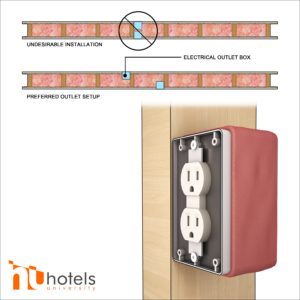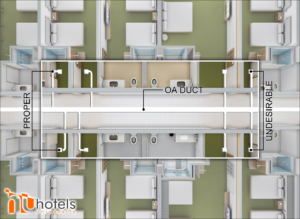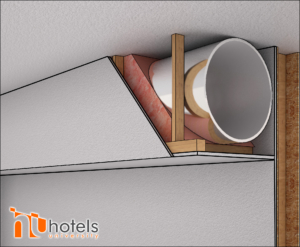How to keep your hotel guestrooms quiet!
Part 5a – Flanking Noise Sources
In previous modules, we discussed the following:
-
The importance of STC ratings to the success of your hotel design (Link To Part I)
-
The minimum STC standards required by your franchises (Link to Part II)
-
Typical wall/ceiling assemblies and their associated STC rating (Link to Part III)
-
Effects of flanking noise on transmission (Link to Part IV)
In this module, we will focus on two of the four most typical sources of flanking noise and how to reduce and eliminate them in your hotel.
As a brief reminder, flanking noise is simply noise that transfers from one space to another via an indirect pathway. Below are two of the most common sources of flanking noise and the related design ideas to reduce such noise in your hotel guestrooms:
1. Electrical Outlet & Light Switch Boxes
One of the most vulnerable locations for flanking noise involves outlets boxes. Because they create holes in the walls, outlets remain one of the most problematic areas for sound transmission. Instead of layers of sound-insulating drywall, outlet areas only have a thin plastic barrier. Since code requires an outlet on each wall, you cannot avoid noise due to outlets. However, you can limit the effects of this source of noise. The savviest hotel designers will use the following strategies to minimize flanking noise caused by outlet vulnerabilities:
-
Avoid installing electrical boxes on the same stud cavity creating a back-to-back condition, as shown in the graphic below. Furthermore, some of the hotel brand standards prohibit back-to-back outlets and require they be offset horizontally by at least 6”.
-
Seal any gaps between electrical outlets and drywall with acoustic seal and putty pads. Putty pads should be manually formed around the back of the outlet and light switch boxes to prevent sound leaks in these vulnerable areas.
2. Ductwork
Another hidden noise pollution offender involves ductwork. Ductwork provides a direct path for air and sound travel, thereby requiring designers to install mechanisms to restrict potential noise pollution. The following suggestions should be utilized to offset noise vulnerabilities in ducts:
-
Avoid simple and direct ductwork paths between guestrooms and other guestrooms or corridor space. More specifically, longer and more complex/indirect duct work (ie., bends/turns in the ductwork) will improve sound performance. This is especially applicable for hotels with directly ducted fresh air to the guestrooms. Note below how the desired OA duct routing includes an offset to each of the guestrooms to avoid a direct sount transfer point between rooms.
-
Use Duct Liner. Most franchises and codes require insulated duct liners, which contain sound-absorbing material to reduce sound transfer within the ducts.






Leave A Comment